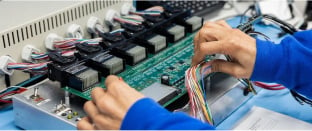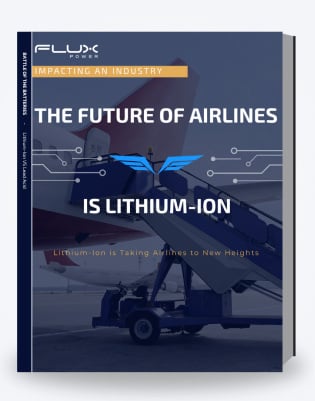For companies that use lead acid batteries to power their material handling equipment, how long their batteries last and how well they perform is critical to their operations.
The maintenance of lead acid batteries plays an important role in both of these outcomes. If not properly maintained, a battery’s lifespan and performance can diminish - impacting efficiency and increasing costs.
Here are some of the most common maintenance mistakes that companies make when servicing lead acid batteries and why lithium-ion batteries are a better alternative that avoids or reduces the likelihood of these issues occurring.
Under Charging
If a lead acid battery is not returned to its full charge after it has been used, it will be undercharged and there is a risk of damaging it.
Partially charging a lead acid battery can cause sulfating, which is the formation of lead sulfate that occurs on the battery’s plates. This diminishes the battery’s performance. It can even lead to battery failure, a costly mistake if your goal is to use a lead acid battery for its estimated lifespan (an average of 1,000 charging cycles).
Why Lithium-ion Batteries are Better:
Unlike lead acid batteries, lithium-ion batteries can be opportunity charged. Partially charging a lithium-ion battery does not damage it and is more convenient because equipment operators can charge the battery as needed during breaks or shift downtimes. And, this doesn’t impact its average lifespan of 2,000 cycles.
Over Charging
 Overcharging a lead acid battery can be just as harmful as undercharging it. If workers leave the battery in a continuously charging state for long periods of time, corrosion of the positive battery plates can occur.
Overcharging a lead acid battery can be just as harmful as undercharging it. If workers leave the battery in a continuously charging state for long periods of time, corrosion of the positive battery plates can occur.
Lead acid batteries can also get very hot while charging. So, if workers overcharge a battery, it can cause damage on the inside due to longer exposure to excessive temperatures.
The odds of this occurring are greater when workers allow the battery to experience a deep discharge, requiring extended time to return the battery to full charge.
If a lead acid battery overcharges and overheats, pressure generated from the hydrogen and oxygen gas must be relieved or it can rupture.
Why Lithium-ion Batteries are Better:
Lithium-ion batteries feature a state-of-the-art battery management system that tracks cell temperatures while charging to ensure they remain in safe temperature ranges. Unlike lead acid batteries, lithium-ion batteries do not require separate charging and cooling areas because of the risks outlined above.
Built-in controllers prevent overcharging, in order to prevent dendrites from forming that can cause significant damage to lithium-ion batteries.
Under Watering
lead acid batteries are filled with an electrolyte solution (sulfuric acid and water) and feature a removable top. They generate electricity through a chemical reaction of the lead plates and sulfuric acid. This type of battery requires regular refilling with water or the chemical process will degrade and the battery will suffer an early failure.
One of the biggest mistakes workers make is under watering the battery. If water that is lost during the charging process is not replenished and the electrolyte levels drop below the top of the plates, significant damage can occur.
In hotter environments, water depletion can occur at an even faster rate.
Why Lithium-ion Batteries are Better:
Because of the way lithium-ion batteries are designed, they do not require watering. Lithium-ion batteries are sealed shut, which means the electricity-generating chemicals stay inside.
Over Watering
Over watering can cause significant damage to a lead acid battery as well. When a battery is over watered, the electrolytes become diluted. This will diminish the battery’s performance.
Over watering also creates the risk of the spillage, which is a dangerous mixture of toxic sulfuric acid.
Why Lithium-ion Batteries are Better:
Again, lithium-ion batteries do not require watering because of the way they are designed. Lithium-ion batteries are sealed shut, so workers do not have to monitor water levels or worry about spills of highly-toxic sulfuric acid occurring.
Other Maintenance Issues
Other mistakes that can impact the performance and lead acid battery life include:
- Forgetting to check ventilation holes: Ventilation holes allow hydrogen gas to escape. If gas is unable to relieve itself, a pressure build-up can cause an instant explosion, resulting in devastating consequences for employees and the facility.
- Skipping a cooldown period: The lifespan of a lead acid battery can be shortened when exposed to extreme temperatures, especially heat. After charging a lead acid battery, workers must ensure it undergoes a cooldown period of 8 hours because the act of charging produces high amounts of heat. A cooldown period allows the battery to resume safe temperatures before going back into service.
- Discharging the battery too deeply: The life of a lead acid battery suffers when a deep discharge occurs and the battery is left “dead” for an extended amount of time. Workers should only discharge a lead acid battery down to about 30% or the battery can be damaged.
Other Reasons Lithium-Ion Batteries Are Better
Lithium-ion batteries offer several features that reduce the risk for common maintenance mistakes.
- One of the best features of a lithium-ion battery is its battery management system. This internal system monitors cell temperatures to ensure they remain in safe operating ranges so there is no risk to employees. It also monitors currents and voltages to ensure they stay at safe levels.
- One of the biggest advantages of lithium-ion batteries is that they don’t require a separate storage area for charging and cooling, which means that businesses can use valuable floor space for more productive purposes.
- Lithium-ion batteries can also be safely discharged down to 20% capacity, allowing equipment operators to utilize the battery longer before it is discharged too deeply.
- All of these features point toward saving companies money by using lithium-ion batteries. Less maintenance means lower costs overall. In fact,
- You can read more about the safety benefits that lithium-ion batteries provide to companies that use material handling equipment in our article,
- .












